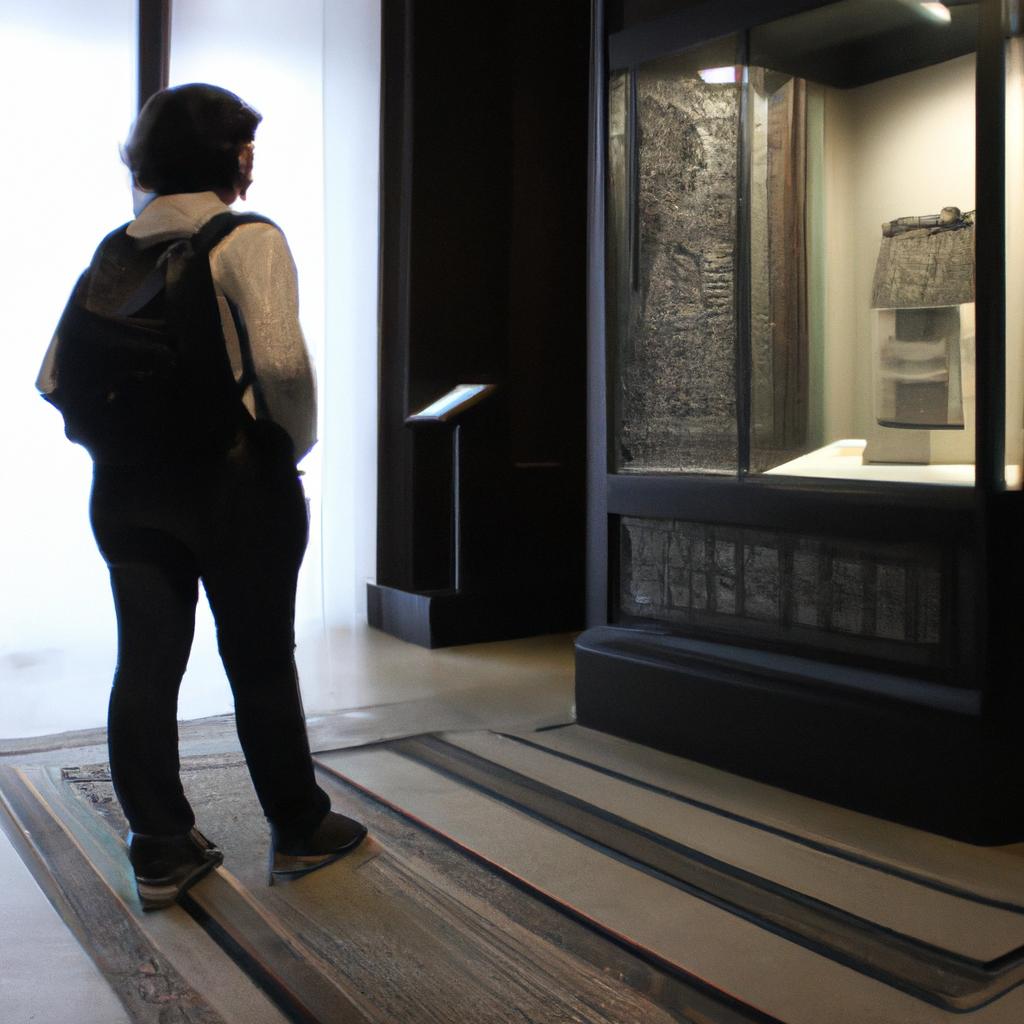The exploration of local traditions and cultural heritage in North America is a fascinating endeavor that allows individuals to delve into the rich tapestry of diverse customs, practices, and beliefs that have shaped communities across the continent. By immersing oneself in these local traditions, one can gain a deeper understanding of the historical, social, and cultural contexts in which they exist. For instance, imagine embarking on a journey through the vibrant streets of New Orleans during Mardi Gras season, where you witness elaborate parades, dazzling costumes, and lively music resonating throughout the city. This captivating experience not only provides an insight into the festive spirit of this unique celebration but also offers glimpses into the centuries-old French Creole culture that thrives within its boundaries.
Engaging with local traditions and exploring cultural heritage is more than just a means of entertainment or leisurely travel; it is an opportunity for individuals to connect with their roots, broaden their perspectives, and foster intercultural dialogue. Whether it be attending powwows hosted by Indigenous communities in Canada or participating in traditional dance ceremonies at Pueblo reservations in New Mexico, such experiences enable travelers to engage directly with living cultures imbued with history and significance. Through firsthand encounters with local artisans, storytellers, musicians, and other community members, one can gain a profound appreciation for the craftsmanship, oral traditions, and artistic expressions that have been passed down through generations.
Moreover, exploring local traditions and cultural heritage in North America allows individuals to challenge stereotypes and misconceptions that may exist about certain communities. By immersing oneself in these experiences, one can break down barriers and foster understanding and empathy towards different cultures and ways of life. This not only enriches our own lives but also contributes to the promotion of diversity, inclusion, and respect within society.
In order to fully engage with local traditions and cultural heritage, it is important to approach these experiences with an open mind and a willingness to learn. Researching beforehand about the customs, etiquette, and significance of specific traditions can provide valuable insights into their historical context. Additionally, being respectful of local customs and practices is crucial in order to ensure that we are participating in these traditions in a culturally sensitive manner.
Overall, exploring local traditions and cultural heritage in North America offers a plethora of opportunities for personal growth, learning, and connection. Whether it be through attending festivals, visiting museums or cultural centers, or engaging directly with community members themselves, this journey of discovery promises to be both enlightening and rewarding.
Traditional Festivals
Traditional festivals play a significant role in showcasing the cultural heritage of communities across North America. These events provide opportunities for locals and tourists alike to immerse themselves in traditional practices, customs, and celebrations. One compelling example is the Mardi Gras festival held annually in New Orleans, Louisiana. This vibrant celebration brings together people from diverse backgrounds to participate in parades, masked balls, and music performances.
Attending traditional festivals can evoke a wide range of emotions within individuals. They serve as reminders of shared cultural values and foster a sense of belongingness among community members. Furthermore, these festive gatherings offer an escape from the mundane routines of everyday life by providing moments of joy, excitement, and entertainment. The following bullet point list highlights some emotional responses that attendees may experience:
- Awe-inspired wonder at elaborate costumes and decorations
- Unbridled laughter during comedic performances or games
- Deep appreciation for the skills displayed in traditional dances or musical performances
- Nostalgia for past traditions and connections to ancestral roots
In addition to evoking emotions, traditional festivals also showcase various aspects of culture through visual displays and interactive experiences. For instance, the table below provides examples of different elements that are commonly featured at such events:
| Element | Description | Significance |
|---|---|---|
| Traditional Cuisine | Local delicacies reflecting culinary heritage | Celebrating regional flavors |
| Artistic Performances | Dance troupes, storytellers, musicians | Preserving oral traditions |
| Cultural Exhibits | Displaying artifacts, crafts, clothing representing traditions | Educating about historical significance |
| Community Participation | Involvement of local residents in organizing and performing | Reinforcing communal bonds |
By participating in these festivals or observing them as spectators, individuals gain insights into diverse cultures while appreciating their rich histories. Such experiences often inspire further exploration into other aspects of the local traditions, leading to a deeper understanding and appreciation for cultural heritage.
Transitioning into the subsequent section on “Art and Crafts,” it becomes evident that traditional festivals not only celebrate culture through performances but also provide opportunities for artisans to showcase their craftsmanship.
Art and Crafts
Exploring the rich cultural heritage of North America, traditional festivals have provided a unique opportunity for locals and tourists alike to immerse themselves in the vibrant traditions of different communities. One such festival that exemplifies this is the Albuquerque International Balloon Fiesta in New Mexico. This annual event attracts thousands of visitors who gather to witness the breathtaking sight of hundreds of colorful hot air balloons dotting the sky.
Traditional festivals not only serve as a celebration but also play a significant role in preserving cultural customs and fostering community unity. These events are often deeply rooted in history, with origins dating back centuries. By participating in traditional festivals, individuals can gain insight into the values, beliefs, and practices that have shaped specific cultures over time.
When attending these festivals, one can expect an array of experiences that evoke an emotional response:
- A diverse range of food stalls offering authentic local cuisine.
- Live performances showcasing traditional music and dance forms.
- Engaging workshops where attendees can learn about traditional crafts and artistry.
- The chance to interact with locals and gain firsthand knowledge about their culture.
To further illustrate the impact of traditional festivals on cultural preservation, consider the following table highlighting distinct celebrations from various regions across North America:
| Festival | Location | Cultural Significance |
|---|---|---|
| Diwali Festival | Toronto | Celebrates Hindu traditions through lights, fireworks, and symbolic rituals |
| Mardi Gras | New Orleans | Embraces French-Creole heritage with parades, costumes, live music, and indulgence before Lent |
| Day of the Dead | Oaxaca | Honors deceased loved ones through elaborate altars decorated with marigolds and sugar skulls |
| Calgary Stampede | Alberta | Showcases cowboy culture with rodeos, chuckwagon races, agricultural exhibitions, and western-style shows |
In summary, traditional festivals serve as powerful vehicles for cultural preservation and exploration. These events provide a platform to celebrate diversity, engage with local communities, and gain insights into the customs that have shaped North America’s rich heritage. Moving forward, we will delve into another significant aspect of cultural exploration: historical landmarks. By immersing ourselves in the architectural wonders and stories behind these sites, we can further deepen our understanding of the region’s intricate history.
Historical Landmarks
Transitioning from the previous exploration of art and crafts, we now delve into the rich historical landmarks that are an integral part of North America’s cultural heritage. To illustrate the significance of these landmarks, let us consider the case study of Jamestown Settlement in Virginia.
Jamestown Settlement stands as a testament to the enduring spirit of early European colonization in North America. Established in 1607 by English settlers, it holds immense historical value as the first permanent English settlement in what is now the United States. The site encompasses a replica fort and several reconstructed buildings that offer visitors a glimpse into life during this pivotal period. Through interactive exhibits and guided tours, individuals can immerse themselves in the history of Jamestown and gain a deeper understanding of its impact on shaping American society.
Exploring such historical landmarks not only provides educational insights but also evokes emotional responses within travelers. Here are some key aspects that contribute to this:
- Sense of awe: Standing before centuries-old structures or artifacts creates a sense of wonder at how our ancestors lived and built civilizations.
- Connection with the past: By walking in the footsteps of those who came before us, we establish a personal connection to history and feel linked to our cultural roots.
- Reflection on progress: Witnessing advancements made over time reminds us of human ingenuity and inspires contemplation about how far we have come as a society.
- Preservation efforts: Recognizing the dedication put into preserving these sites instills appreciation for cultural heritage and promotes sustainable tourism practices.
To further highlight various significant landmarks across North America, below is a table showcasing three notable examples:
| Landmark | Location | Year Established | Noteworthy Feature |
|---|---|---|---|
| Statue of Liberty | New York City | 1886 | A symbol welcoming immigrants |
| Mount Rushmore | South Dakota | 1927 | Monumental sculptures of four presidents |
| Alcatraz Island | San Francisco, California | 1934 | Former federal prison now a national park |
As we approach the end of this section on historical landmarks, it is important to acknowledge that these sites are not the sole representation of North America’s cultural heritage. Indigenous communities have played an integral role in shaping the region’s history and traditions. In understanding their unique perspectives and contributions, we gain a more comprehensive appreciation for the diverse tapestry that makes up North American culture.
Next Section: Indigenous Communities
Indigenous Communities
Exploring the rich tapestry of North America’s cultural heritage takes us beyond historical landmarks and into the vibrant world of indigenous communities. These communities are a testament to the resilience, diversity, and traditions that have shaped this vast land. To delve deeper into their unique customs and beliefs is to truly understand the essence of local traditions in North America.
Imagine visiting a Native American reservation nestled amidst picturesque landscapes. Here, you can witness firsthand how ancient traditions coexist with modern influences. For instance, at the Pine Ridge Indian Reservation in South Dakota, visitors can immerse themselves in Lakota Sioux culture through traditional ceremonies, powwows, and storytelling sessions held by tribal elders. This case study exemplifies the significance of preserving indigenous cultures while embracing contemporary ways of life.
To fully appreciate the richness of indigenous communities across North America, it is crucial to acknowledge three key aspects:
-
Cultural Preservation: Indigenous communities strive to preserve their ancestral practices despite societal changes. Through language revitalization programs, art exhibitions featuring traditional craftsmanship, and oral history projects passed down from generation to generation, these communities ensure that their cultural legacies endure.
-
Environmental Stewardship: Many indigenous communities possess an intimate connection with nature and actively promote sustainable practices like responsible tourism and wildlife conservation efforts. Their deep respect for Mother Earth serves as a reminder for all travelers to tread lightly upon this beautiful planet we share.
-
Intergenerational Knowledge Transfer: Elders play a pivotal role in passing down knowledge about rituals, healing techniques, and other sacred teachings to younger generations within indigenous societies. This transfer ensures the preservation of wisdom accumulated over centuries and fosters a sense of unity among community members.
Let us now explore these aspects further through the following table:
| Aspect | Description |
|---|---|
| Cultural Preservation | Efforts made by indigenous communities to safeguard their age-old traditions |
| Environmental | Practices promoting sustainability and reverence for the natural world |
| Stewardship | |
| Intergenerational | Transmission of cultural knowledge from older to younger generations |
| Knowledge Transfer |
As we continue our exploration of North America’s local traditions, it becomes evident that these indigenous communities are essential custodians of their respective cultures. Their unwavering commitment to preserving their heritage and sharing it with others serves as an inspiration for cultural enthusiasts and travelers alike.
In transitioning to the next section on “Regional Cuisine,” we embark on a culinary journey that further highlights the diversity and distinctiveness of North American culture. The flavors, ingredients, and cooking techniques unique to each region provide insight into the historical roots and multicultural influences that shape this continent’s gastronomic landscape.
Regional Cuisine
Exploring the rich cultural heritage of North America, our journey now takes us from the vibrant traditions of Indigenous communities to the delectable world of regional cuisine. As we delve into this fascinating aspect of local tradition exploration, let us consider a hypothetical example: Imagine stepping into a charming coastal town in Maine, where lobster rolls reign supreme and seafood shacks line the picturesque harbor.
Regional Cuisine:
In our quest for authentic experiences, indulging in regional cuisine allows us to truly immerse ourselves in the local culture. Each region within North America boasts its own unique culinary delights, shaped by historical influences, geographical features, and available ingredients. Whether it’s feasting on gumbo in Louisiana or savoring poutine in Quebec, these dishes become more than just food; they represent a tangible connection to the people and their stories.
To evoke an emotional response and whet your appetite further, here are some mouthwatering examples:
- Succulent barbecue ribs slathered with tangy sauce in Kansas City
- Crispy fish tacos topped with fresh salsa verde in Baja California
- Warm beignets dusted with powdered sugar in New Orleans
- Savory bannock bread served alongside wild game stew at a powwow gathering
Embracing the diversity of regional cuisines also means embracing different cooking techniques, flavors, and dining customs. With each bite taken, we embark on a sensory journey that transcends borders and unites cultures across time.
Table: A Taste of Regional Delights
| Region | Signature Dish | Noteworthy Ingredient(s) | Cultural Significance |
|---|---|---|---|
| Southern U.S. | Shrimp & Grits | Stone-ground cornmeal | Reflects African-American roots |
| Mexico | Mole Poblano | Chocolate | Symbolizes indigenous heritage |
| Nova Scotia | Lobster Rolls | Fresh lobster meat | Celebrates coastal fishing culture |
| Pacific Northwest | Clam Chowder | Razor clams | Honors Native American traditions |
Appreciating regional cuisine goes beyond the mere act of eating; it allows us to connect with the history, geography, and people of a particular place. By embracing these culinary experiences, we gain insight into the cultural fabric that makes North America so diverse.
Transitioning seamlessly into our next topic, music and dance hold equal importance in preserving heritage and fostering community bonds. From lively foot-stomping rhythms to graceful movements, let us now explore the expressive world of Music and Dance in North America.
Music and Dance
Previous section H2:’Regional Cuisine’
Next section H2:’Music and Dance’
Having explored the diverse regional cuisines of North America, our journey now takes us to another captivating aspect of cultural heritage – music and dance. Just as regional cuisine reflects a unique blend of history, geography, and local traditions, music and dance also play an integral role in shaping the cultural identity of different communities across this vast continent.
To illustrate the profound impact that music and dance have on preserving cultural heritage, let us consider the case study of Cajun culture in Louisiana. The lively sounds of accordion-led Zydeco music accompanied by energetic foot-stomping dances embody the spirit of this vibrant community. This example highlights how music and dance serve as powerful mediums for storytelling, passing down traditions from one generation to another while fostering a sense of belonging among individuals who share a common heritage.
Bullet Point List (evoking emotional response):
- Engages individuals in communal celebrations, forging connections beyond language barriers.
- Preserves ancestral customs through rhythmic expressions that carry forward historical narratives.
- Creates a shared experience where people can express joy, sorrow, love, or resilience collectively.
- Promotes intergenerational bonding by involving all age groups in musical performances and traditional dances.
Table (evoking emotional response):
| Celebration | Region | Key Elements |
|---|---|---|
| Mardi Gras | New Orleans | Vibrant parades with colorful floats; Enchanting jazz bands filling the streets; Lively street parties |
| Powwow | Indigenous Tribes | Traditional drumming circles; Elaborate tribal regalia; Spirited intertribal dances |
| Carnaval | Rio de Janeiro | Samba rhythms pulsating throughout the city; Extravagant costumes and elaborate floats; Energetic dance competitions |
| St. Patrick’s Day | New York City | Irish folk music performances; Spectacular parade featuring bagpipes and step dancing; Green-themed festivities |
Music and dance act as conduits for cultural preservation, providing a medium through which communities can express their history, values, and traditions. These art forms transcend boundaries, uniting people from all walks of life in joyous celebrations or solemn rituals. By embracing these rich cultural expressions during our travels across North America, we not only gain insight into diverse heritage but also foster a deeper appreciation for the shared humanity that connects us all.
 Island Gourmet Safaris
Island Gourmet Safaris



